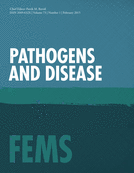-
PDF
- Split View
-
Views
-
Cite
Cite
Editorial: New insights into Chlamydia: from genes to diseases in humans and animals, Pathogens and Disease, Volume 73, Issue 1, February 2015, Page 1, https://doi.org/10.1093/femspd/ftv010
Close - Share Icon Share
The Chlamydiales are a bacterial order of the phylum Chlamydiae consisting of obligate intracellular organisms. A unifying hallmark of the order is the unique biphasic developmental cycle, which takes place inside a eukaryotic host in a special compartment formed by the bacteria, the inclusion. Despite this seemingly complicated life Chlamydiae are amazingly successful. Not only have humans and many animals their own adapted chlamydial species, there is a plethora of “environmental chlamydiae”, more recently recognized bacteria that live in symbiotic association with protozoan hosts, especially amoebae. Needless to say, there is much that we still don't know about these bacteria, from the intricacies of their interaction with their hosts, over the epidemiology and carriage of chlamydial species to the potential the various species hold to cause disease in different host species.
We are not saying Chlamydiae are more interesting than other bacteria. To us however this special association of different life forms holds particular appeal. What are the factors that permit establishment in a membrane-bound vacuole in a host cell? How is the host cell induced to accept this vacuole as if it were another organelle, and to supply it with nutrients? What are the factors that determine the decision between low-grade, inapparent and a fulminant infection? What determines the host range of these bacteria?
The German Chlamydia Workshop started as a yearly national meeting for researchers working in the field of Chlamydia. It has since attracted more and more researchers and now is certainly and with certain pride recognized as an international conference. In April 2014, the German Chlamydia Workshop was held in Berlin at the Robert Koch-Institute and offered, as always, the opportunity for the Chlamydia community to share their unpublished findings in a protected environment. The array of wonderful research on the various facets of Chlamydia biology and infection was the spark that set off this Thematic Issue.
This issue gathers research looking at Chlamydia from a number of angles. Here are examples: the potential role of Chlamydia psittaci and environmental Chlamydia species as emerging human pathogens is discussed by Vorimore et al., Greub et al. and their co-workers. The two studies suggest that C. psittaci and environmental Chlamydia species are ubiquitous in places of commercial animal-rearing. The recent description of two new avian Chlamydia species, Chlamydia avium and Chlamydia gallinacea suggests that these new players must be taken into account in future studies and demonstrates Chlamydia's high diversity and its potential to evolve (Sachse and colleagues).
The observation that culture-conditions change the virulence of Chlamydia pneumoniae in a mouse model is an unexpected finding (Klos and coworkers); genetic polymorphisms of Chlamydia muridarum are shown to affect the biology of the bacteria (Ramsey and colleagues). On the host side, polymorphisms in the intracellular pattern-recognitions receptors, NOD1 and NOD2, are found to affect the severity of C. trachomatis infections in women (Morré and coworkers), suggesting that recognition by the host's immune system may explain varying clinical findings.
Of course, many questions remain unanswered and Chlamydia will continue to intrigue us for the time to come. Just as Robert Koch said, “Ich will nicht locker lassen”, we will not let go, and will continue to unveil the secrets of Chlamydia. For now, we hope that this thematic issue is an appropriate and enjoyable-to-read demonstration of the tremendous recent progress that has been made in our field.
Viviane Bremer, Guest Editor; E-mail:BremerV@rki.de
*Dagmar Heuer, Guest Editor; E-mail:HeuerD@rki.de
Georg Häcker, Guest Editor; E-mail:georg.haecker@uniklinik-freiburg.de
Corresponding editor.



